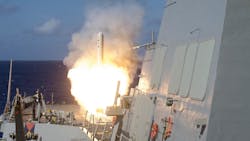Raytheon to start full-scale development of bunker-busting Tomahawk missile with penetrating warhead
PATUXENT RIVER NAS, Md. – U.S. Navy land-attack experts are asking the Raytheon Co. to start full-scale development of a blast and penetration warhead to enable the Tomahawk missile to destroy bunkers and other hardened targets.
Officials of the Naval Air Systems Command at Patuxent River Naval Air Station, Md., announced a $90.4 million contract last week to the Raytheon Missile Systems segment in Tucson, Ariz., for the engineering and manufacturing development (EMD) phase of the Joint Multiple Effects Warhead System (JMEWS).
The JMEWS project seeks to improve the Tactical Tomahawk Land-Attack Missile for bunker busting and large-area target capability. EMD is the final phase of weapons development before full-scale production.
JMEWS is developing a warhead that combines blast-fragmentation and enhanced penetration in one warhead. This would enable the Tomahawk to attack soft targets like parked aircraft, vehicles, and formations of soldiers, as well as hardened targets like bunkers, underground command posts, and aircraft in hardened shelters.
Related: Raytheon moves ahead with bunker busting cruise missile upgrades to Tomahawk
For JMEWS, Raytheon is designing a two-stage warhead in a multi-effects system to destroy a wide variety of targets. During an August 2010 test, the JMEWS creating a hole large enough in a reinforced bunker for the missile's follow-through element to penetrate the concrete target and pass through two witness plates.
The JMEWS warhead will be for the Raytheon Tomahawk Block V missile, which is scheduled to start production this year. Some Block V missiles will have bunker-busting capability, while others will be able to attack moving targets at sea. The missile can fire from surface warships and from submerged submarines. Existing Block IV Tomahawks will be converted to Block Vs, and the remaining Block III missiles will be retired.
JMEWS is to give the Tomahawk cruise missile increased flexibility and lethality against heavily defended and hardened targets like bunkers, underground laboratories, and missile facilities. This capability is to give military commanders the option of attacking heavily defended and dynamic targets without using manned aircraft.
On this contract Raytheon will do the work in Tucson, Ariz.; Cincinnati; Plymouth, Minn.; and Rocket Center, W.Va., and should be finished by November 2023. For more information contact Raytheon Missile Systems online at www.raytheon.com, or Naval Air Systems Command at www.navair.navy.mil.

John Keller | Editor-in-Chief
John Keller is the Editor-in-Chief, Military & Aerospace Electronics Magazine--provides extensive coverage and analysis of enabling electronics and optoelectronic technologies in military, space and commercial aviation applications. John has been a member of the Military & Aerospace Electronics staff since 1989 and chief editor since 1995.

